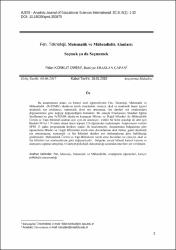| dc.contributor.author | Korkut Owen, Fidan | |
| dc.date.accessioned | 2020-07-20T07:05:03Z | |
| dc.date.available | 2020-07-20T07:05:03Z | |
| dc.date.issued | 2018 | en_US |
| dc.identifier.citation | Korkut Owen, F, Eraslan Çapan, B. (2018). Fen, teknoloji, matematik ve mühendislik alanları: seçmek ya da seçmemek. Anadolu Journal of Educational Sciences International (AJESI), 8 (1), 1-32. | en_US |
| dc.identifier.issn | 2146-4014 | |
| dc.identifier.uri | https://hdl.handle.net/11421/24258 | |
| dc.description.abstract | Bu araştırmanın amacı on birinci sınıf öğrencilerinin Fen, Teknoloji, Matematik ve
Mühendislik (FeTEMM) alanlarını tercih etmelerinin cinsiyet, okul ve akademik başarı (genel
akademik not ortalaması, matematik dersi not ortalaması, fen dersleri not ortalamaları)
değişkenlerine göre değişip değişmediğini bulmaktır. Bu amaçla Uluslararası Standart Eğitim
Sınıflaması’na göre FeTEMM alanlarını kapsayan Müsbet ve Doğal Bilimleri ile Mühendislik
Üretim ve Yapı Bilimleri alanları ayrı ayrı ele alınmıştır. Veriler bir form aracılığı ile dört ayrı
lisedeki 98 kız 118 erkek olmak üzere toplam 216 öğrenciden toplanmıştır. Araştırmanın verileri
SPSS 13 paket programında kaykare analizi ile incelenmiştir. Araştırmanın bulgularına göre
öğrencilerin Müsbet ve Doğal Bilimlerini tercih etme durumlarının okul türüne, genel akademik
not ortalamasına, matematik ve fen bilimleri dersleri not ortalamalarına göre farklılaştığı
görülmüştür. Mühendislik Üretim ve Yapı Bilimlerini tercih etme durumları ise cinsiyet, okul ve
fen bilimleri not ortalamalarına göre değişmektedir. Bulgular, sosyal bilişsel kariyer kuramı ve
alanyazın ışığında tartışılmış ve kariyer psikolojik danışmanlığı açısından önerilere yer verilmiştir. | en_US |
| dc.description.abstract | The purpose of this study was to examine possible factors influencing the selection of
Science, Technology, Enginering and Mathematic (STEM) related university study areas
according to International Standard Classification of Education (ISCED). According to ISCED,
two of the eight education areas are related with STEM: Positive and Natural Science (PNS) and
Enginering, Production and Structure (EPS). Because of that these two areas were investigated
seperately. Among the factors considered possibly significant were gender, school type, and
cumulative grade point average. The respondents in this investigation were 216 high school 11th
grade students from four high schools (98 female, 118 male). Data were collected through the use
of a survey form used to record demographic information as well as self-reported preferences for
these STEM related two fields of university study. The resulting survey data were subjected to a
chi-squared test analysis using SPSS 13. According to the findings, it was found that except
gender, other variables were significant factors to consider for PNS areas. On the other hand
except cumulative grade point average other variables were significant factors to consider for EPS
areas. These findings were discussed in light of current literature and implications for counseling
were offered. | en_US |
| dc.language.iso | tur | en_US |
| dc.publisher | Anadolu Üniversitesi | en_US |
| dc.rights | info:eu-repo/semantics/openAccess | en_US |
| dc.subject | Fen | en_US |
| dc.subject | Teknoloji | en_US |
| dc.subject | Matematik ve Mühendislik | en_US |
| dc.subject | Ortaöğretim Öğrencileri | en_US |
| dc.subject | Kariyer Psikolojik Danışmanlığı | en_US |
| dc.title | Fen, teknoloji, matematik ve mühendislik alanları: seçmek ya da seçmemek | en_US |
| dc.title.alternative | Stem areas: choice or not to choice | en_US |
| dc.type | article | en_US |
| dc.relation.journal | Anadolu Journal of Educational Sciences International (AJESI) | en_US |
| dc.contributor.department | Anadolu Üniversitesi | en_US |
| dc.identifier.volume | 8 | en_US |
| dc.identifier.issue | 1 | en_US |
| dc.identifier.startpage | 1 | en_US |
| dc.identifier.endpage | 32 | en_US |
| dc.relation.publicationcategory | Makale - Ulusal Hakemli Dergi - Kurum Öğretim Elemanı | en_US |
| dc.contributor.institutionauthor | Eraslan Çapan, Bahtiyar | |


















